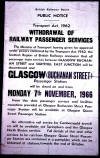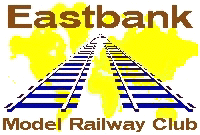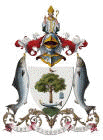 |
This
is Glasgow Queen Street Station as it was in September 1962. The road bridge
above is Cunningham Street and was used as a makeshift bus departure point.
The signal box controlling the station is just behind the signal gantry. The
signal box is now long gone but the supporting bridge is still present.
Summer 1962. |
 |
This
is the intersection between Argyle Street and Hope Street to the north and
Oswald Street to the south. Below the tram is Glasgow Central low level and
is still in service at this time. Summer 1962. |
 |
This
is Glasgow St. Enoch Station and we are about to depart for a day at the
seaside, probably Largs. St. Enoch Station, Corkerhill allocated BR Class 5 73100 and the ex
LMS non corridor passenger carriages will not be
around for much longer. June 1966. |
 |
The
death sentence of St. Enoch Station has been proclaimed and will soon be
executed. As of the 27th of June 1966 no more service trains will use the
station. Services were subsequently transferred to Glasgow Central. June
1966. |
 |
Arkleston Cutting
is just east of Paisley Gilmour Street and Class 5. 73064 passes just before
the demise of steam operations on the south Clyde Coast lines.
Electrification work from Glasgow Central to Gourock and Wemyss Bay is in
progress. The centre two lines have been removed and masts have been
installed though not always in that sequence. Forty years or so later a
single extra running line was reinstated requiring the relocation of the all
the masts to the outside. June 1966. |
 |
Now
the death sentence for Glasgow Buchanan Street Station has been proclaimed.
As of the 7th of November 1966 no more service trains will use the station.
Services were subsequently transferred to Glasgow Queen Street. November
1966. |
 |
Lonely at the end of the platform the final service train awaits departure
for Inverness. November 1966. |
 |
This
is Glasgow Buchanan Street Station on the final evening in service, the 6th
of November 1966. The closure notice is displayed above the ticket office.
November
1966. |
 |
The
final departures are displayed. The penultimate departure is for Aberdeen
via Forfar and the very last train from Buchanan Street Station is for
Inverness. After that we all went home. November 1966. |
 |
This
is not Glasgow but is Paisley Gilmour Street Station. The train originated
in Glasgow Central and illustrates the short period between the end of steam
working and full electric services on the Gourock and Wemyss Bay lines. Note
the adequate provision of passenger vehicles, a sight not often encountered
today. July 1967. |
 |
Taken
from the eastbound platform at Newton, a Class 40 heads west with a load of
black diamonds. July 1967. |
 |
The
original Freightliner terminal in Glasgow was at Gushetfaulds adjacent to
the main line into Glasgow Central. This is June 1968. |
 |
The
two Class 25 locomotives are at the approach to Polmadie engine shed.
Note the somewhat utilitarian signal box controlling the entrance. June 1968. |
 |
This
is looking southbound on the West Coast Main Line as it passes Polmadie
engine shed. This view is taken from the road bridge on Polmadie Road.
June 1968. |
 |
Looking northbound from the road bridge on Polmadie Road, an almost brand new
Class 50 D410 heads for Polmadie engine shed. June 1968. |
 |
Again
looking northbound from the road bridge on Polmadie Road a southbound
freight passes. June 1968. |
 |
In
the past, persons interested in trains were usually made welcome to visit
engine sheds and Polmadie depot was no exception. In those days we all had
common sense to look out for and avoid any hazards, did we not? In the
present day regime of elf 'n softie litigation, blame culture and no win no
fee shyster lawyers, this pleasure has been denied to all. June 1968. |
 |
This
Freightliner train has just left Gushetfaulds terminal and is southbound for
England. June 1968. |
 |
This
is Dalmuir Station and a Class 20 returns with some oil tankers off the West
Highland Line. June 1968. |
 |
Steam
did not quite disappear from Eastfield Depot with the end of steam traction.
One Class 4MT, 80002 remained as a static steam generator for heating
coaching stock. April 1969. |
 |
This locomotive
received a reprieved and was restored and now resides on the
Keighley and Worth Valley Railway. It is seen adjacent to Cowlairs signal
box. April 1969. |
 |
This
scene was taken from the abandoned ex Caledonian Possil line where it
crossed over the Glasgow-Edinburgh line and was an excellent viewing point
for observing the locomotives at Eastfield Depot. The abandoned bridge was
later removed and subsequently Eastfield depot was closed and
demolished. History repeated itself and a new depot has now appeared on the
site. April 1969. |
 |
With
the introduction of the May 1974 timetable, the "Electric Scots" service
became operational on the West Coast Main Line. To promote this major
service improvement a duplicate 87001 was built. However this full size
replica was made of wood. After being exhibited in the McLellan Galleries in
Glasgow the replica was displayed for some time on a barge on the river
Clyde. The exhibit was safeguarded by a man in a rowing boat as the barge was
considered a hazard to navigation if it detached its moorings. May 1974. |
 |
May
1974 saw the introduction of full electric service to Glasgow on the West
Coast Main Line. Unlike today, virtually all trains, passenger and freight,
made use of this electrification. The wooden replica 87001 remained in full
view for some time. May 1974. |
 |
Glasgow St. Enoch Station remained unused for a number of years after
closure before suffering the penultimate insult, being used as a car park.
Don't be fooled by the sign, the roof was not repaired, just demolished. The
final insult was the destruction of this fine station and hotel to be
replaced with yet another shopping centre. Just what Glasgow really needed! If you've seen one shopping
centre, you've seen a mall. September 1975. |
 |
The
view from the station concourse. The platforms and roadbed have been
levelled as the covered area was used as a car park. At this time when the
roof was being "repaired?" this area was fenced off. September 1975. |
 |
St.
Enoch Station also had quite a large engine shed. This was located near the
City of Glasgow Union line. This of course disappeared on the demolition of
the whole St. Enoch site. September 1975. |
 |
This
is Queen's Dock and is now out of use. The large crane in the distance is
the Finnieston Crane, once used to load locomotives onto ships for export.
The whole dock area was subsequently filled in and the Scottish Events
Campus or SEC (formerly named the Scottish Exhibition
and Conference Centre) now resides here. October 1975. |
 |
This
is McWilliam scrap yard (no doubt today it would be called a materials
reclamation and recycling facility) and the only two inmates are a pair of
Class 17 Clayton locomotives. The Claytons did not have much of a long life
but at least they did outlive the NB2 Class 21 & 29 locomotives. October
1975. |
 |
McWilliam scrap yard was located adjacent to the Glasgow to Airdrie line
about mid way between Shettleston and Garrowhill Stations. Access was
without restriction as there was no fence. After all, who would want to
pilfer a locomotive? How things have changed. October 1975. |
 |
This
is Glasgow Central Station Low Level just before the rebuilding of the
Argyle Line. The original station had four through platforms but was rebuilt
with only two lines and a single island platform. This view is from
Wellington Street looking east. No doubt the original
configuration of four platform faces would be much appreciated today both at
Central and at Queen Street. July 1976. |
 |
Now
round to Hope Street and we are looking west. It now becomes clear that
Glasgow Central Low Level is not directly beneath the upper station but is
actually to the west between Hope Street and Wellington Street. July 1976. |
 |
This
is St. Enoch Station Hotel as seen from the south side of St. Enoch Square.
It will not be here for much longer as the overall train shed has now been
demolished. July 1976. |
 |
Many
people at this time would not realise that there was a railway tunnel
underneath Argyle Street running from Glasgow Cross to Anderson Cross. The
line closed in 1964 but was reopened in 1979 as part of the Argyle Line. A
new station named Argyle Street was provided just opposite Marks & Spencer.
A peculiarity of this station is that when you alight from a train you have
to descend before ascending to reach street level. This is Argyle street
before pedestrianisation and the construction of the station entrance. July
1976. |
 |
There
were once two stations near to Glasgow Cross, Gallowgate on the high level
City of Glasgow Union Line and Glasgow Cross on the underground Argyle Line.
Both stations are long closed but their respective lines remain open. This
is the entrance to Glasgow Cross Station which was closed in 1964. No doubt
the closeness of road traffic to the station entrance would be frowned upon
today. July 1976. |
 |
Glasgow Cross Station was noted for having a rather unique wall around the
open area. It was made of metal and each panel had an embossed CR for
Caledonian Railway logo. On the reopening of the Argyle Line in 1979 the
open area was covered over and the panels removed. The CR panels were last
seen adorning a public toilet at St. Vincent Place. Glasgow Cross station
did not open as a new station was opened at Argyle Street instead. July
1976. |
 |
At
one time there were many coal fired power station in Glasgow, usually next
to the River Clyde. This is Clydesmill at Carmyle. Of course the coal was
delivered by rail. September 1976. |
 |
During the rebuilding of the Argyle Line, much modification was done to the
infrastructure resulting in a reduction of the original capacity. Here at
Stobcross Station the original route to Kelvinside was used as the eastbound
platform and a new burrowing junction was provided. On reopening, the station
was named Finnieston and later became Exhibition due to the nearby Scottish
Exhibition and Conference Centre which is reached by an overhead opaque plastic
tunnel. March 1977. |
 |
Another view of Queen's Dock taken from above Stobcross (Exhibition)
Station. In the distance there is a Class 303 Blue Train passing Kelvinhaugh
Junction. Note the sparse level of road traffic on the Clydeside Expressway, a
scenario never experienced today. The dock area is now occupied by the
Scottish Events Campus or SEC (formerly named the Scottish Exhibition and Conference Centre). March 1977. |
 |
In
the late 1970's the Glasgow Underground or as referred to in Glasgow, the
Subway, was rebuilt. This is Govan Station where the original island
platform was replaced with two much wider platforms making loading and
unloading much easier. July 1977. |
 |
Here
a couple of the original Subway cars are show discarded and at the mercy of
the local vultures. They have already began to feast. July 1977. |
 |
Unusual sights in George Square. Before being dispatched to a permanent life
underground, one of the new Subway cars was exhibited to the public at the
western edge of George Square. July 1977. |
 |
The
public were invited to peruse the interior of the first of the new Subway
cars. July 1977. |
 |
This
is Dalmarnock Station during the refurbishment of the Argyle Line. Closed in
1964, it reopened in 1979. Paved track has been installed but not much more.
There was no restriction on access in those days. If you injured yourself,
it was your own stupid fault, no one else's. Dalmarnock Station has recently
been refurbished once again for a sporting event. The much more conveniently
located Parkhead Stadium Station remains buried and forgotten. July 1977. |
 |
This
is Bridgeton Cross station and work is in progress restoring the Argyll line
to Rutherglen. In the far right may be seen the supports holding up London
Road A74 above what was once an island platform on the diverting route to
Carmyle via Parkhead Stadium and Tollcross. It was a lost opportunity that
this line was not included in the reopening as it passed through well
populated areas unlike the Rutherglen to Carmyle line. July 1979. |
 |
Another station included in the reopening of the Argyll Line was the much
modified Stobcross Street station. Originally there was no platform on the
link to Kelvinhaugh Junction. The station was eventually renamed Finnieston
and later Exhibition due to the proximity of the Scottish Events Campus.
July 1979. |
 |
This
is Bellgrove and we are most fortunate to see a short freight train heading
for High Street Goods Depot. February 1982. |
 |
This
train passing Bellgrove coveys international ferry vans operated by
Transfesa. These vans would have arrived in the UK via a roll on roll off
train ferry, probably via the Dunkerque to Dover Western Docks train ferry
"Pas de Calais". February 1982. |
 |
At
Bellgrove a single Class 37 heads west. The area on the left was the site of
the cattle unloading platform where live animals left on their final journey
to the adjacent abattoir. On the siding for the cattle platform, the rails
were set in concrete to allow for easy cleaning of any animal waste from the
cattle wagons. This area was subsequently landscaped but the embedded track
remains buried for some future industrial archaeologist to make an exciting
discovery. February 1982. |
 |
This
scene was taken from the abandoned ex Caledonian Possil line where it
crossed over the Glasgow-Edinburgh line and was an excellent viewing point
for observing the locomotives at Eastfield Depot. Before any bean counter
surmises that Scottish Region have a surfeit of locomotives, this scene was
captured during the national railwayman's strike in July 1982. The abandoned
bridge was later removed and subsequently Eastfield depot was closed and
demolished. History repeated itself and a new depot has now appeared on the
site. July 1982. |
 |
This
is Glasgow Central Station in July 1982. The astute viewer will notice that
no trains are scheduled to depart, platform displays 1 to 13 are empty. This
was due to a national railwayman's strike that month. The station shop and
bars were still open for business though. July 1982. |
 |
A
view of Platform 3 and 4. Note that the overnight sleeping car train has not
been returned to Polmadie Depot for servicing. Further up the train is the
unique Pullman Bar Car "Hadrian's Bar. However this bar is not open for
business. July 1982. |
 |
Over
now to Queen Street Station and a Glasgow Aberdeen train remains after
arrival. After the Glasgow Edinburgh trains were replaced with Class 47-7,
five MK.3 and a Mk2f DBSO (Driving Brake Second Open) extra DBSO cars were
available for use with Class 47-7 and various air braked Mk.2 carriages for
Aberdeen and Inverness services. July 1982. |
 |
Without dispute, the best trains ever to operate on the Glasgow to Edinburgh
via Falkirk route. For most of the 1980's the Class 47-7, four Mk.3 Tourist
Second Opens, a Mk.3 Open First (later replaced with a Mk.3 Open Composite)
and a Mk.2f Driving Brake Second Open formation all with Inter-City quality
seating shuttled back between Glasgow and Edinburgh on a tight schedule.
Around 1990 they were replaced with Class 156, then Class 158 and now Class
170 DMU's, all unfortunately
fitted with high density commuter seating. May 1985. |
 |
Just
how low can you get in Glasgow and remain in the open air? Probably in Govan. This scene is
taken from the bottom of Govan dry dock some twenty or so feet below river
level. The Sealink ship Antrim Princess, still railway owned and in British
Rail blue is receiving some attention. January 1983. |
 |
At
one time the public could get even lower in Glasgow but this time time it
was underground, well actually under water. The first tunnels under the
Clyde were at Finnieston where two vehicular and a pedestrian tunnel
existed. Road traffic ceased quite early on but the foot tunnel remained
open until 1980. Access was gained via the north and south rotundas.
Photo: David Black. |
 |
This
is not a railway station, it's a bus station. This is an evening view of
Buchanan Bus Station. August 1994. |
 |
It
would be another thirty years before another railway exhibit appeared in
George Square. This is South African Railways North British Locomotive
Company built Class 15F 4-8-2 3007. It resided in George Square for a short
time before reaching its final resting place in the Glasgow Riverside
museum. August 2007.
Photo: David Black. |
 |
This
locomotive was saved from the scrap line at Bloemfontein in South Africa. It
travelled by rail to Durban, by sea to Germany and then to Immingham. The
journey to Glasgow was by road due to the large size of the locomotive and
of course its track gauge of 3' 6". It is now one of the largest exhibits in the
Glasgow Riverside museum. August 2007.
Photo: David Black. |

